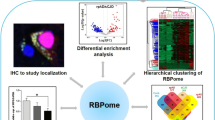Abstract
Alzheimer’s disease (AD) is the most common neurodegenerative disorder of aging, accounting for an estimated two-thirds of all cases of senile dementia. Using bioinformatics, the yeast two-hybrid-system, reverse transcription polymerase chain reaction, and fluorescence microscopy analysis, we demonstrate here that the new putative splicing regulatory protein p18SRP is a lysine-rich zinc finger domain-containing protein that interacts with the serine-arginine (SR)-rich splicing regulatory protein SRrp86. The additional finding of its down-regulation in the brain of AD subjects points to a possible pivotal role of p18SRP in the control of cellular survival.
Similar content being viewed by others
References
Akatsu H., Takahashi M., Matsukawa N., et al. (2002) Subtype analysis of neuropathologically diagnosed patients in a Japanese geriatric hospital. J. Neurol. Sci. 196, 63–69.
Barnard D. C., Li J., Peng R., and Patton J. G. (2002) Regulation of alternative splicing by SRrp86 through coactivation and repression of specific SR proteins. RNA 8, 526–533.
Braak H. and Braak E. (1991) Neuropathological staging of Alzheimer-related changes. Acta Neuropathol. 82, 239–259.
Faustino N. A. and Cooper T. A. (2003) Pre-mRNA splicing and human disease. Genes Dev. 17, 419–437.
Heese K., Nagai Y., and Sawada T. (2002a) Characterizing rat p18 amyloid beta (Aβ) responsive protein p18AbrP. Brain Aging 2, 30–38.
Heese K., Yamada T., Nagai Y., and Sawada T. (2002b) CGI-94 controls neuronal survival. Brain Aging 2, 44–48.
Kuhn A. N. and Kaufer N. F. (2003) Pre-mRNA splicing in Schizosaccharomyces pombe. Regulatory role of a kinase conserved from fission yeast to mammals. Curr. Genet. 42, 241–251.
Li J., Barnard D. C., and Patton J. G. (2002) A unique glutamic acid-lysine (EK) domain acts as a splicing inhibitor. J. Biol. Chem. 277, 39485–39492.
Mirra S. S., Heyman A., McKeel D., et al. (2000) The Consortium to Establish a Registry for Alzheimer’s Disease (CERAD). Part II. Standardization of the neuropathological assessment of Alzheimer’s disease. Neurology 41, 479–486.
Sanford J. R., Longman D., and Caceres J. F. (2003) Multiple roles of the SR protein family in splicing regulation. Prog. Mol. Subcell. Biol. 31, 33–58.
Selkoe D. (2001) Alzheimer’s disease: genes, proteins, and therapy. Physiol. Rev. 81, 741–766.
Sobrido M. J., Miller B. L., Havlioglu N., et al. (2003) Novel tau polymorphisms, tau haplotypes, and splicing in familial and sporadic frontotemporal dementia. Arch. Neurol. 60, 698–702.
Wang J., Takagaki Y., and Manley J. L. (1996) Targeted disruption of an essential vertebrate gene: ASF/SF2 is required for cell viability. Genes Dev. 10, 2588–2599.
Author information
Authors and Affiliations
Corresponding author
Rights and permissions
About this article
Cite this article
Heese, K., Fujita, M., Akatsu, H. et al. The splicing regulatory protein p18SRP is down-regulated in alzheimer’s disease brain. J Mol Neurosci 24, 269–275 (2004). https://doi.org/10.1385/JMN:24:2:269
Received:
Accepted:
Issue Date:
DOI: https://doi.org/10.1385/JMN:24:2:269




